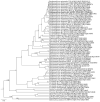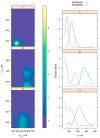Production of Fluorescent Dissolved Organic Matter by Microalgae Strains from the Ob and Yenisei Gulfs (Siberia)
- PMID: 36501400
- PMCID: PMC9735766
- DOI: 10.3390/plants11233361
Production of Fluorescent Dissolved Organic Matter by Microalgae Strains from the Ob and Yenisei Gulfs (Siberia)
Abstract
Dissolved organic matter (DOM) is an important component of aquatic environments; it plays a key role in the biogeochemical cycles of many chemical elements. Using excitation-emission matrix fluorescence spectroscopy, we examined the fluorescent fraction of DOM (FDOM) produced at the stationary phase of growth of five strains of microalgae sampled and isolated from the Ob and Yenisei gulfs. Based on the morphological and molecular descriptions, the strains were identified as diatoms (Asterionella formosa, Fragilaria cf. crotonensis, and Stephanodiscus hantzschii), green microalgae (Desmodesmus armatus), and yellow-green microalgae (Tribonema cf. minus). Three fluorescent components were validated in parallel factor analysis (PARAFAC): one of them was characterized by protein-like fluorescence (similar to peak T), two others, by humic-like fluorescence (peaks A and C). The portion of fluorescence intensity of humic compounds (peak A) to the total fluorescence intensity was the lowest (27 ± 5%) and showed little variation between species. Protein-like fluorescence was most intense (45 ± 16%), but along with humic-like fluorescence with emission maximum at 470 nm (28 ± 14%), varied considerably for different algae strains. The direct optical investigation of FDOM produced during the cultivation of the studied algae strains confirms the possibility of autochthonous production of humic-like FDOM in the Arctic shelf regions.
Keywords: Arctic; PARAFAC; algae; biogeochemical cycles; dissolved organic matter; fluorescence; molecular biology; morphology.
Conflict of interest statement
The authors declare no conflict of interest. The funders had no role in the design of the study; in the collection, analyses, or interpretation of data; in the writing of the manuscript, or in the decision to publish the results.
Figures














Similar articles
-
[Sources, Characteristics and Transformation Dynamics of Fluorescent Dissolved Organic Matter in the Silin Reservoir].Huan Jing Ke Xue. 2019 Mar 8;40(3):1209-1216. doi: 10.13227/j.hjkx.201807268. Huan Jing Ke Xue. 2019. PMID: 31087967 Chinese.
-
[Spatial Distribution Characteristics and Source Analysis of Dissolved Organic Matter in Beiyun River].Huan Jing Ke Xue. 2016 Aug 8;37(8):3017-3025. doi: 10.13277/j.hjkx.2016.08.024. Huan Jing Ke Xue. 2016. PMID: 29964727 Chinese.
-
Biogeochemistry of the dissolved organic matter (DOM) in the estuarine rivers of Bangladesh-Sundarbans under different anthropogenic influences.Heliyon. 2022 Aug 12;8(8):e10228. doi: 10.1016/j.heliyon.2022.e10228. eCollection 2022 Aug. Heliyon. 2022. PMID: 36042731 Free PMC article.
-
Characteristics of Dissolved Organic Matter in Sediments of Typical Lakes in Southeastern Hubei Province, China.Int J Environ Res Public Health. 2022 Jun 16;19(12):7402. doi: 10.3390/ijerph19127402. Int J Environ Res Public Health. 2022. PMID: 35742651 Free PMC article.
-
Optical and molecular indices of dissolved organic matter for estimating biodegradability and resulting carbon dioxide production in inland waters: A review.Water Res. 2023 Jan 1;228(Pt A):119362. doi: 10.1016/j.watres.2022.119362. Epub 2022 Nov 14. Water Res. 2023. PMID: 36427460 Review.
Cited by
-
Recent Advances in the Integrative Taxonomy of Plants.Plants (Basel). 2023 Dec 7;12(24):4097. doi: 10.3390/plants12244097. Plants (Basel). 2023. PMID: 38140423 Free PMC article.
-
The Co-Evolution Aspects of the Biogeochemical Role of Phytoplankton in Aquatic Ecosystems: A Review.Biology (Basel). 2023 Jan 6;12(1):92. doi: 10.3390/biology12010092. Biology (Basel). 2023. PMID: 36671784 Free PMC article. Review.
References
-
- Fogg G. The role of algae in organic production in aquatic environments. Br. Phycol. Bull. 1963;2:195–205. doi: 10.1080/00071616300650021. - DOI
-
- Romankevich E.A., Vetrov A.A., Peresypkin V.I. Organic matter of the World Ocean. Russ. Geol. Geophys. 2009;50:299–307. doi: 10.1016/j.rgg.2009.03.013. - DOI
-
- Lobus N.V. Biogeochemical Role of Algae in Aquatic Ecosystems: Basic Research and Applied Biotechnology. J. Mar. Sci. Eng. 2022;10:1846. doi: 10.3390/jmse10121846. - DOI
-
- Thornton D.C.D. Dissolved organic matter (DOM) release by phytoplankton in the contemporary and future ocean. Eur. J. Phycol. 2014;49:20–46. doi: 10.1080/09670262.2013.875596. - DOI
Grants and funding
LinkOut - more resources
Full Text Sources
Miscellaneous

